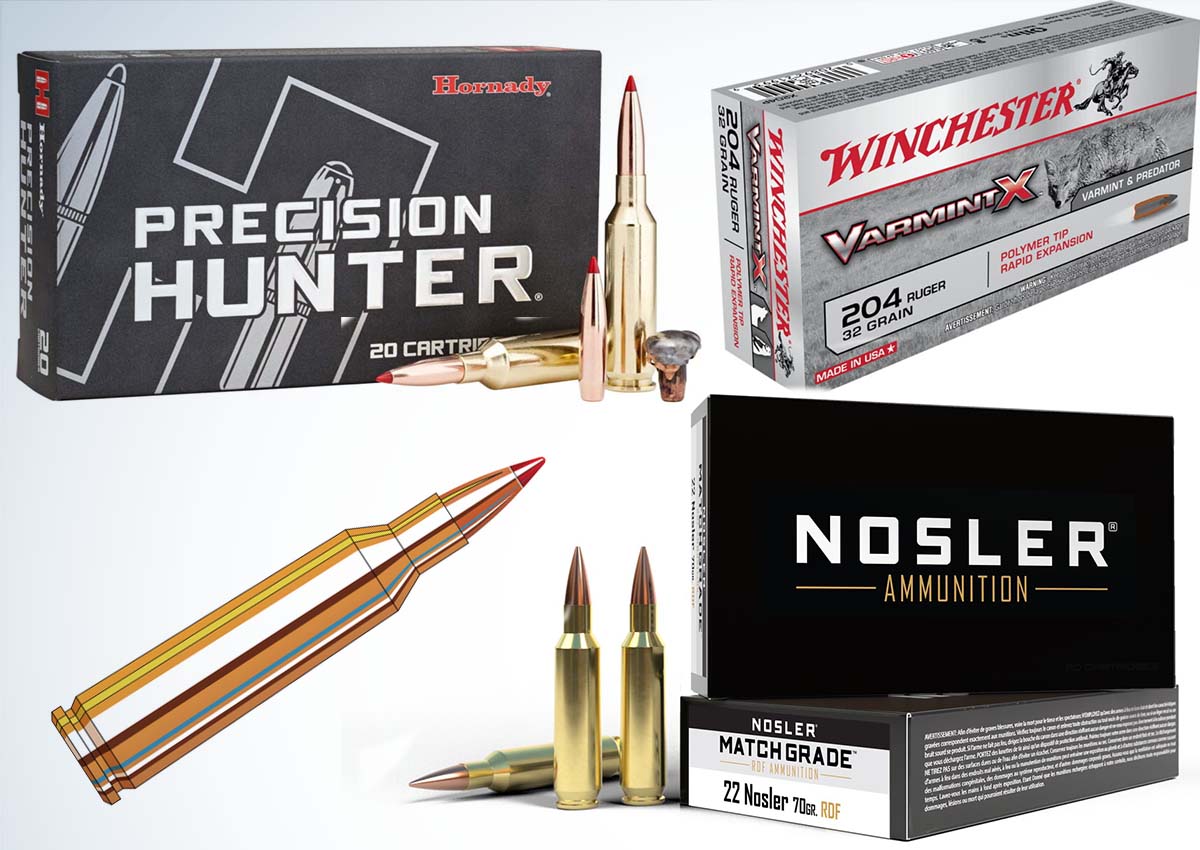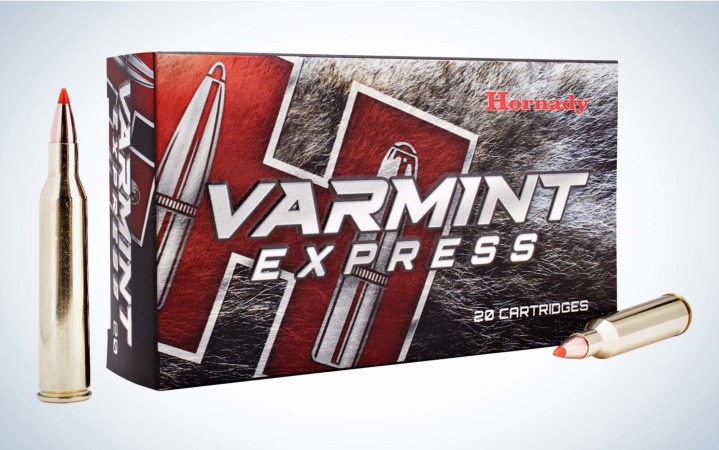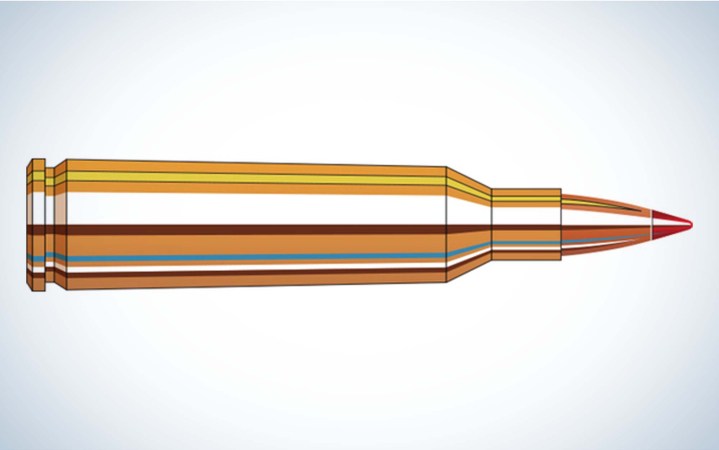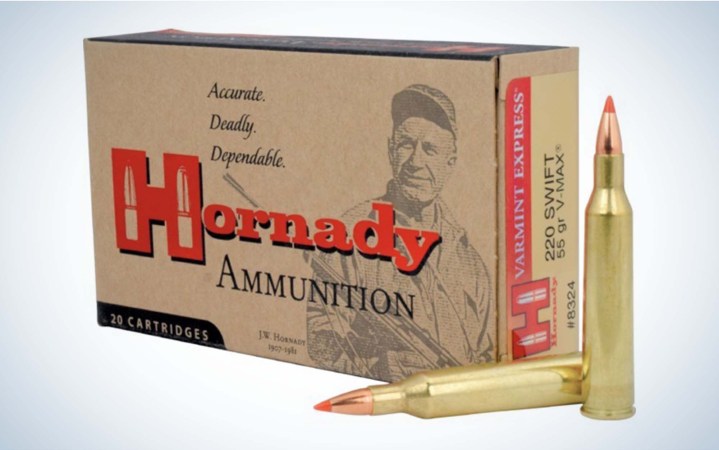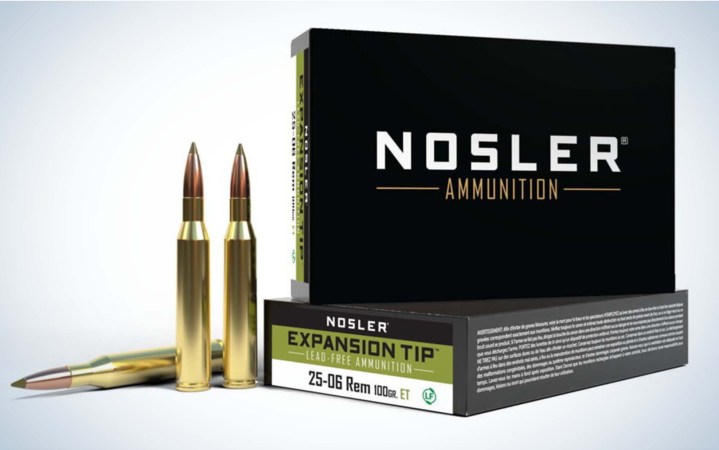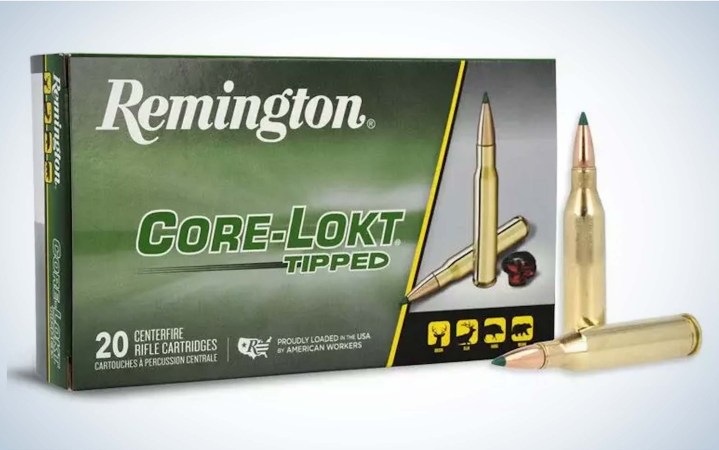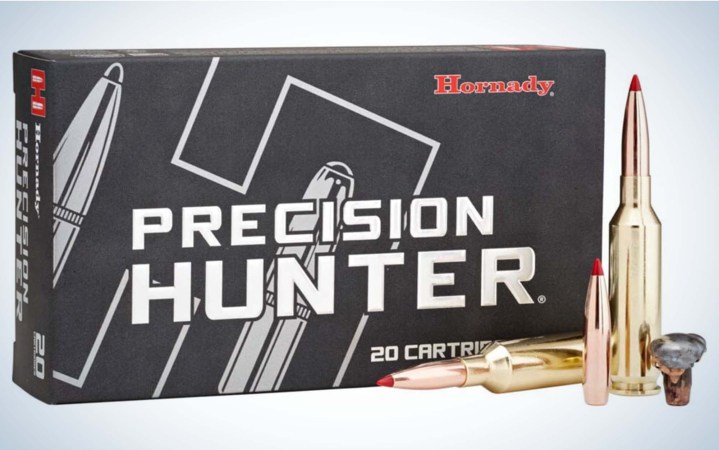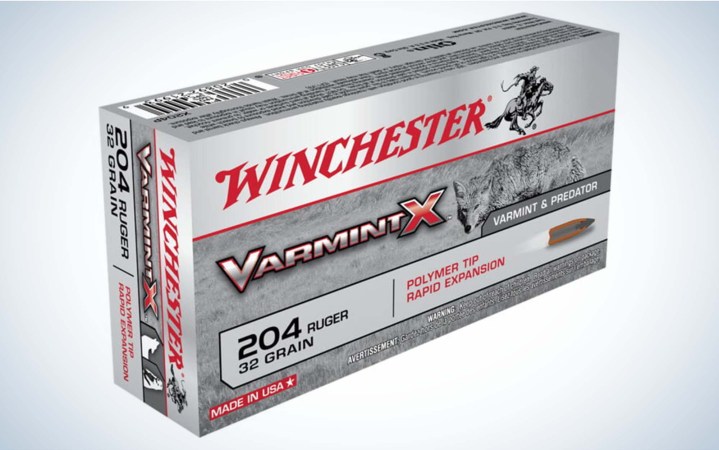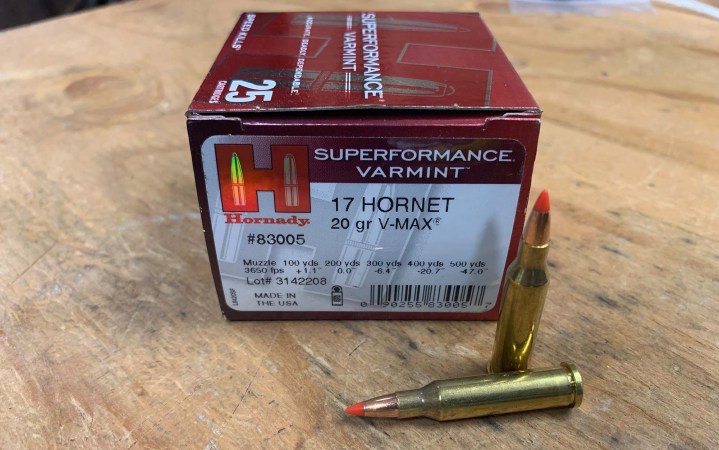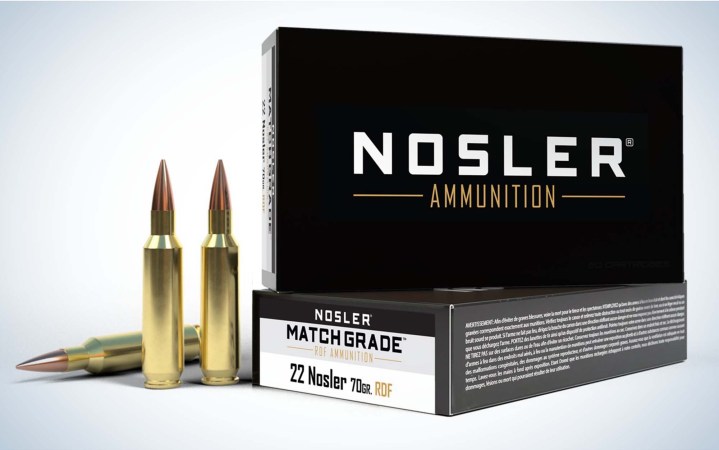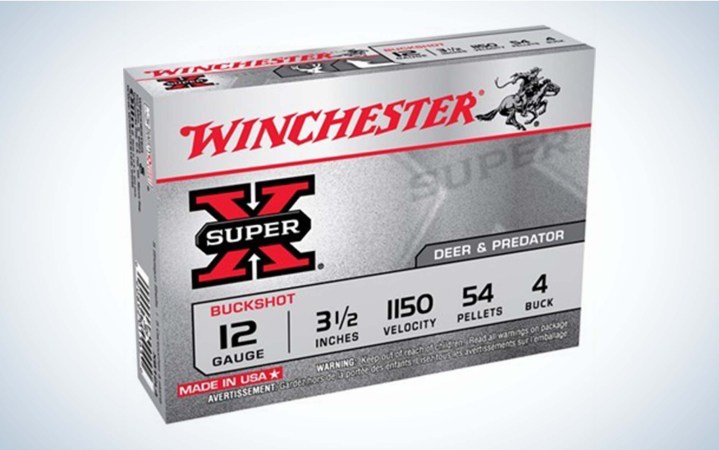We may earn revenue from the products available on this page and participate in affiliate programs. Learn More ›
When deciding on the best coyote caliber or cartridge, your choice says a lot more about you (and the way you hunt) than it does about coyotes. There is no universally superior coyote caliber or cartridge, but if you take a few factors into consideration, you can certainly pick the best one for you. Your style of hunting, the areas you hunt, whether you’re salvaging fur, and other animals you might hunt with the same gun are all things that matter.
Hunting coyotes was a pastime that developed and tuned my hunting skills as a kid. My dad and I spent years of winter weekends out calling and improving our game. Through trial and error, we learned calling and setup techniques, honed our shooting skills, and developed our own opinions and speculations about what the best coyote caliber is.
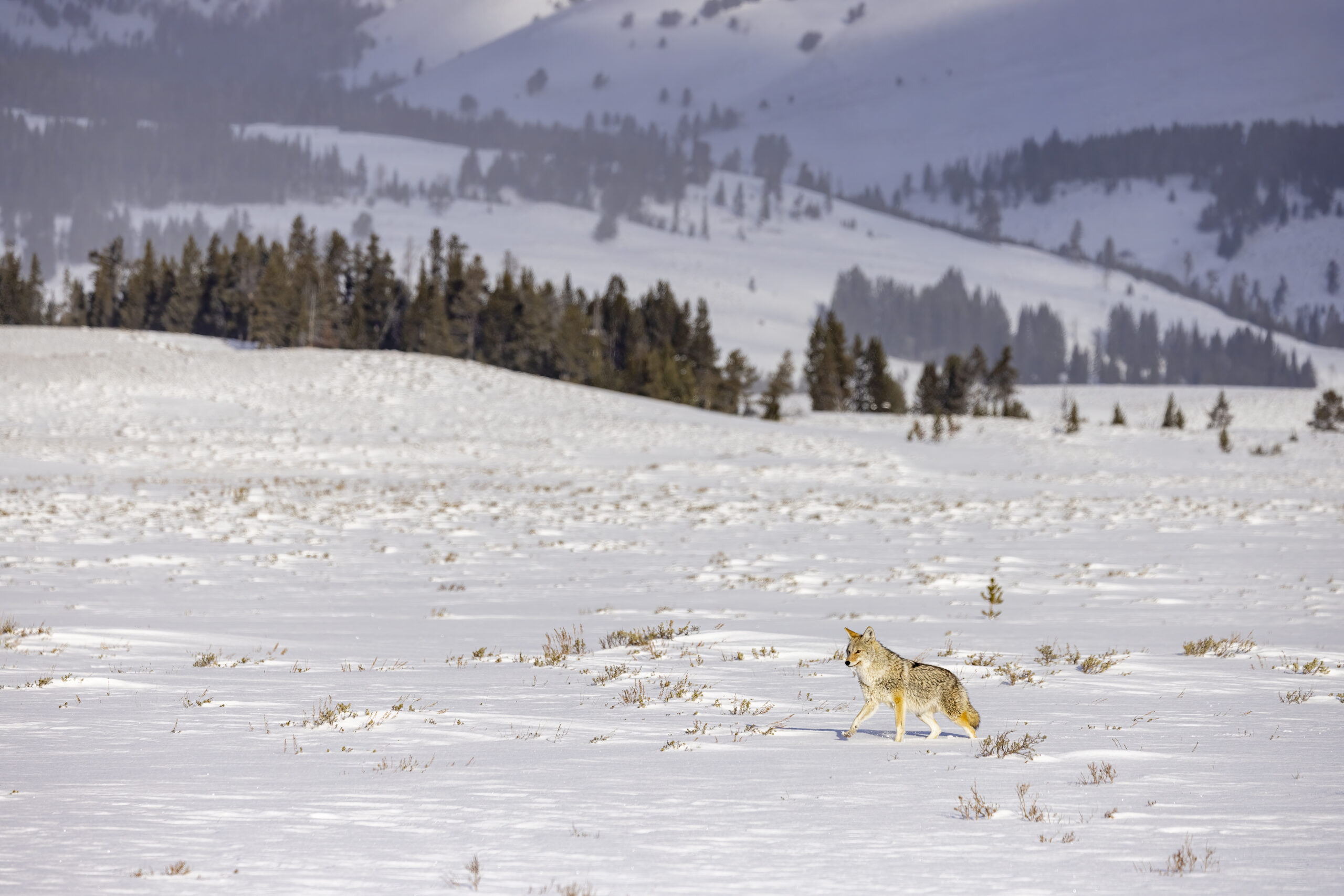
The “Lights-Out” .22’s
Pound-for-pound, there are few animals as tough as a coyote, and some of the most popular coyote cartridges reflect that. Poorly hit coyotes can absorb lead like no other animal and be difficult to recover. Most coyote hunters want a cartridge that will drop them on the spot with a generous margin for error. They usually choose cartridges that are disproportionately powerful compared to what we hunt big game with.
The most popular of these are .22-caliber cartridges that push bullets at blistering speeds. Shooting bullets between 40 and 55 grains, these classic coyote killers deliver tremendous terminal ballistics. Coupled with rapidly expanding varmint bullets, any center-mass hit on a coyote within a few hundred yards will often drop them in their tracks. Relative to bodyweight, these cartridges deliver energy that would be like shooting an 800-pound bull elk with something that has twice or three times the energy of a .50 BMG.
.223 Remington
The most popular coyote cartridge is likely the .223 Rem. It owes its status to the military and chambering in AR-style rifles, but it happens to make an excellent coyote cartridge too. The .223 gets knocked by some coyote hunters for being under-powered, but when used with light varmint bullets under 300 yards, it hits coyotes hard.
I’ve shot a lot of coyotes with a .223 and I don’t remember any that didn’t drop quickly from a center-mass shot. For the fur-conscious coyote hunter, the .223 usually does minimal hide damage with light expanding bullets, but that’s not always the case. Although FMJ ammo is plentiful and doesn’t usually damage hides badly, the terminal performance is relatively poor.
Availability and versatility are the .223’s biggest advantages to a coyote hunter. Both bolt-action and AR-style rifles are accurate, and even modern braced pistols can be effective coyote killers with 50- or 55-grain varmint bullets. The key to achieving knock-down results with a .223 is selecting a good bullet and keeping shots within reasonable ranges.
Read Next: Best 5.56 Ammo
.22/250 Remington
If there’s a standard-setting cartridge in coyote hunting, it’s the .22/250 Rem. This cartridge is almost 90 years old and spent the first three decades of its existence as a wildcat before being officially brought into the fold by Remington in 1965. It’s essentially a .250/3000 Savage (one of the first commercial cartridges to break 3000 fps) that’s necked down to .22-caliber. The .22/250 is capable of velocities of over 4000 fps, impressive for a compact cartridge.
While growing up in Colorado, I noted that a .22/250 is what every rancher seemed to have in their truck’s gun rack or sitting on the dashboard. My uncle still boasts about killing a coyote across one and a half sprinkler quarters (roughly 1,300 yards) with my dad’s Ruger .22/250 back around 1980. He does admit that he wouldn’t believe it himself if he hadn’t done it.
The .22/250 can shoot a range of bullets, but you’ll most commonly see 50- or 55-grain loads. Hornady’s V-Max varmint bullet is an excellent option, and you can expect 50-grain loads to kick out the muzzle at around 3800 fps. At those speeds, the .22/250 takes coyote-flattening power significantly farther than the .223 but does tend to blow bigger holes in pelts. This cartridge can be an excellent performer with heavier bullets too, but the standard 1:12-inch twist rate isn’t ideal for bullets heavier than 55 grains or so.
.220 Swift
Despite being eclipsed by the .22/250 in popularity, some die-hard coyote hunters still consider the .220 Swift to be king. It was introduced in 1935, an era before BCD reticles and adjustable turrets. It was a time where pure speed is what made a cartridge suitable for long-distance varminting. Commonly loaded with 48- to 55-grain bullets, the Swift averages around 4000 fps, but its capable of breaking 4600 fps with 36-grain bullets.
The first coyote I saw shot with a .220 Swift expired quickly. It was at 80 yards, and once the dust settled, Steph Curry could have thrown a basketball through the exit wound. Loaded with light bullets, the Swift is more of an ideal wolf rifle. Famed Alaskan predator control agent and market hunter Frank Glaser fell hard for the Swift in the late 1930’s. He claimed that nothing killed hoofed game more quickly than a lung shot with a 48-grain soft-point bullet out of the Swift.
The .22/250 is a more efficient cartridge that nearly matches the .220 Swift’s incredible velocity, and it can be tough to find factory rifles chambered in .220 Swift these days. However, if you’re feeling nostalgic, and don’t plan on selling your hides, the Swift will knock coyotes as flat as anything.
Big-Game Crossovers
Not every hunter wants or needs a dedicated coyote rifle, and many want to have the best coyote caliber that they can also hunt big game with. Killing power isn’t an issue with big-game cartridges on coyotes, but a rifle that is flat-shooting and low-recoiling is advantageous. With proper bullet selection, some of these crossover cartridges won’t tear up hides too bad either.
.25/06 Remington
Not long after the .30/06 was adopted by the U.S. military, wildcatters began necking it down. Although the .25/06 was officially introduced in 1969, versions of it had already been around for decades. It uses a range of bullets mostly between 90 and 120 grains. The .25/06 is low-recoiling, fast, and hits hard. It’s an excellent big-game cartridge, and its flat trajectory and accuracy are ideal for quick shots out to 300 yards or so on coyotes.
Just as the .25/06 is under-appreciated for big game, it’s not given its due credit for coyote hunting. It’s accurate, friendly to handloaders, and can be loaded to 3600 fps with 75-grain varmint bullets and powders like Varget and IMR 4350. With a load like that, a coyote won’t be able to differentiate between your .25/06 and a .220 Swift. 100-grain mono-metal loads like Nosler’s E-Tip deliver great velocity and excellent penetration on big-game, but because of their limited expansion, don’t seem to destroy pelts as badly as some of the lead-core varmint bullets do in this caliber.
.243 Winchester
Perhaps the ultimate big-game/coyote crossover cartridge is the .243 Win. A ballistic twin, the .244 Remington was introduced with varmints and coyotes in-mind, but the .243 ultimately overshadowed it. Former OL Shooting Editor Jim Carmichel tested both cartridges extensively to determine why the .243 Win. stood out, and it’s because of its twist rate. The .243 Win. can shoot light varmint bullets well but can also handle heavier 90 and 100-grain big game bullets.
If you’re wanting flat-out knock-down on coyotes with a .243, go with the lightest bullet you can get to shoot well. Something like a 58-grain Hornady V-Max can be pushed up to 3,800 feet per second and will deliver lightning blows to coyotes. Heavier bullets in the 90 and 100-grain range aren’t quite as sporty, but they’ll work just fine too.
6mm Creedmoor
Although the 6mm Creedmoor only slightly edges out the .243 Win. in velocity with light 6mm bullets, it breaks away when it comes to shooting coyotes at long-range, using heavier low-drag bullets. Although you may be feeling a nervous twitch run down your spine at the mention of “Creedmoor,” it’s undeniable that this one makes an excellent coyote round. So do many other tight-twisted 6mm wildcats. The 6mm Creedmoor was developed by Hornady and our own John B. Snow as a 6mm wildcat that could shoot heavy-for-caliber bullets, and it just happens that they’ll fit in a standard AR-10 magazine.
The 6mm Creedmoor is a great medium-sized big game rifle, but if you’re looking for a predator crossover for 300 or 400 yards and under, you won’t gain much over the .243 Win. If open country and stupid-long shots at coyotes are your jam though, it may be the best coyote caliber and cartridge for you. A 103-grain ELDX won’t be leaving the muzzle at shocking speed, but at long distances, it’ll deliver great accuracy and plenty of energy on coyotes.
Best for Fur
A critical deciding factor in the coyote caliber or cartridge you choose is whether you’re interested in pelting out. Some areas need the predator control, but the coyotes aren’t worth squat. In that case, the only result that matters is that the coyote doesn’t take another step. It’s not as simple if you’re wanting quality fur too.
To collect maximum yield from coyotes you’re shooting, the damage to the pelt needs to be kept to a minimum, or at least repairable. For an animal as tough as a coyote, it’s a delicate balance between delivering a lighting-like blow and preserving the relatively thin and fragile skin. I’ve shot them with many calibers, including saboted 52-grain Speer hollow points out of a .30/06, a load that can be considered “volatile.” Even the milder .223 can give mixed results on pelts. Hot .17-caliber cartridges with tiny bullets like the .17 Rem. can work well, though it’s especially difficult to find ammunition for.
.204 Ruger
The .204 Ruger is pretty much what my dad and I spent many frosty mornings in his ’74 F-150 speculating as the ultimate coyote cartridge while we bounced along two-track roads between calling stands. We’d seen the effectiveness and damage of .22/250’s and .220 Swifts, as well as the limitations of the .223 (sometimes the .223 damaged hides too). We figured that with an ultra-fast bullet of the right weight and a smaller caliber, one could benefit from high velocity without blowing melon-sized holes in the hide. Our vision was realized a few years later with the .204 Ruger.
The .204 is essentially a necked-down .222 Rem, with some changes to the shoulder geometry. Factory loads will push a 32-grain bullet at 4000 feet per second or better. It won’t hang with the 6mm’s at long distance, but it’s essentially a dead-on hold out to 300 yards and delivers the goods. There’s always a chance of fur damage — we’re shooting the coyotes after all — but these tiny bullets seem to do very well at expanding and not exiting coyotes that are shot square in the body. When they do exit, the damage is usually repairable.
.17 Hornet
For fur-conscious hunters who target a mixed bag that includes bobcats, lynx, or fox, in addition to coyotes, I believe the .17 Hornet to be the ultimate cartridge. I first used the .17 Hornet for fox on Afognak Island here in Alaska. Cartridges like the .223 tended to blow big holes in the hides, and although the .17 HMR and .22 WMR worked, anything but a perfect shot would require a follow-up. In contrast, pretty much every fox I’ve hit solidly in the body (from 20 to 300 yards) with the .17 Hornet reacted as if struck by lightning.
Factory Hornady Ammo loaded with a 20-grain V-Max leaves the muzzle at 3650 feet per second (.22/250 velocities) but does surprisingly little damage to fur. I’ve shot many foxes and several lynx (which are notoriously thin-skinned), and often the bullet doesn’t exit. When it does, the hole is usually the size of a quarter.
The .17 Hornet is small for a dedicated coyote round, and it typically won’t drop them in their tracks. However, it will kill them very effectively and do minimal pelt damage. Frontal and broadside shots are very effective, but usually the coyote will do some spinning before nosing in. Surprisingly, the 20-grain V-Max will typically exit on broadside shots, but like fox, the exit is usually about the size of a quarter.
The Modern .22’s
With the advancements of modern cartridge design, cartridges have become measurably more efficient and effective for the powder they burn. Part of this efficiency involves shooting low-drag, heavy-for-caliber bullets. With the correctly twisted barrel and perhaps some custom magazines or chamber reaming, you could always shoot heavier 70-, 80-, or even 90-grain bullets out of cartridges like the .223 and .22/250, but the ball is being pushed forward by new cartridges every day.
Cartridges like the .22 Nosler, .22 Creedmoor, and .224 Valkyrie all aim to capture niche territory between the ultra-fast light-to-medium-weight 22-caliber bullets and the light 6mm bullets. Are they effective coyote killers? I’m sure. Whether they bring the goods to out-shine the powerhouses that bracket their performance has yet to be seen.
Shotguns
If you’re calling coyotes, especially in brushy or wooded terrain, the best coyote caliber might not be a rifle at all. Coyotes responding to calls can appear at close-range and full-speed, and I can’t count the number of them I’ve had run across my lap—only to miss them with my rifle. I found that especially when calling in tight quarters, a shotgun is the ultimate equalizer for coyotes, fox, lynx, and bobcats. A shotgun is also much cheaper than the average tricked-out coyote rifle.
There really isn’t much to a coyote, and a concentrated dose of heavy pellets will knock them down as quick as any rifle. As a kid, I killed them effectively with BB and T shot, but several companies have dedicated coyote-mix 12-gauge loads that are effective past 50 yards with the right choke. I haven’t tried, but I’d imagine that some of the small-shot TSS turkey loads would be deadly too.
Many coyote hunters will naturally gravitate towards 00 buck. It’s on every sporting goods store shelf, and that’s what cops use right? Well, in a 3.5-inch shell, a 00 Buck load will have 15 pellets. A 3.5-inch shell loaded with No. 4 Buck holds 54, and they’re damned effective. I’ve skinned over 350 wolves while working for a fur buyer—many of them shot out of an airplane with No. 4 buck. It’s death on wolves, coyotes, and might be exactly what you need.
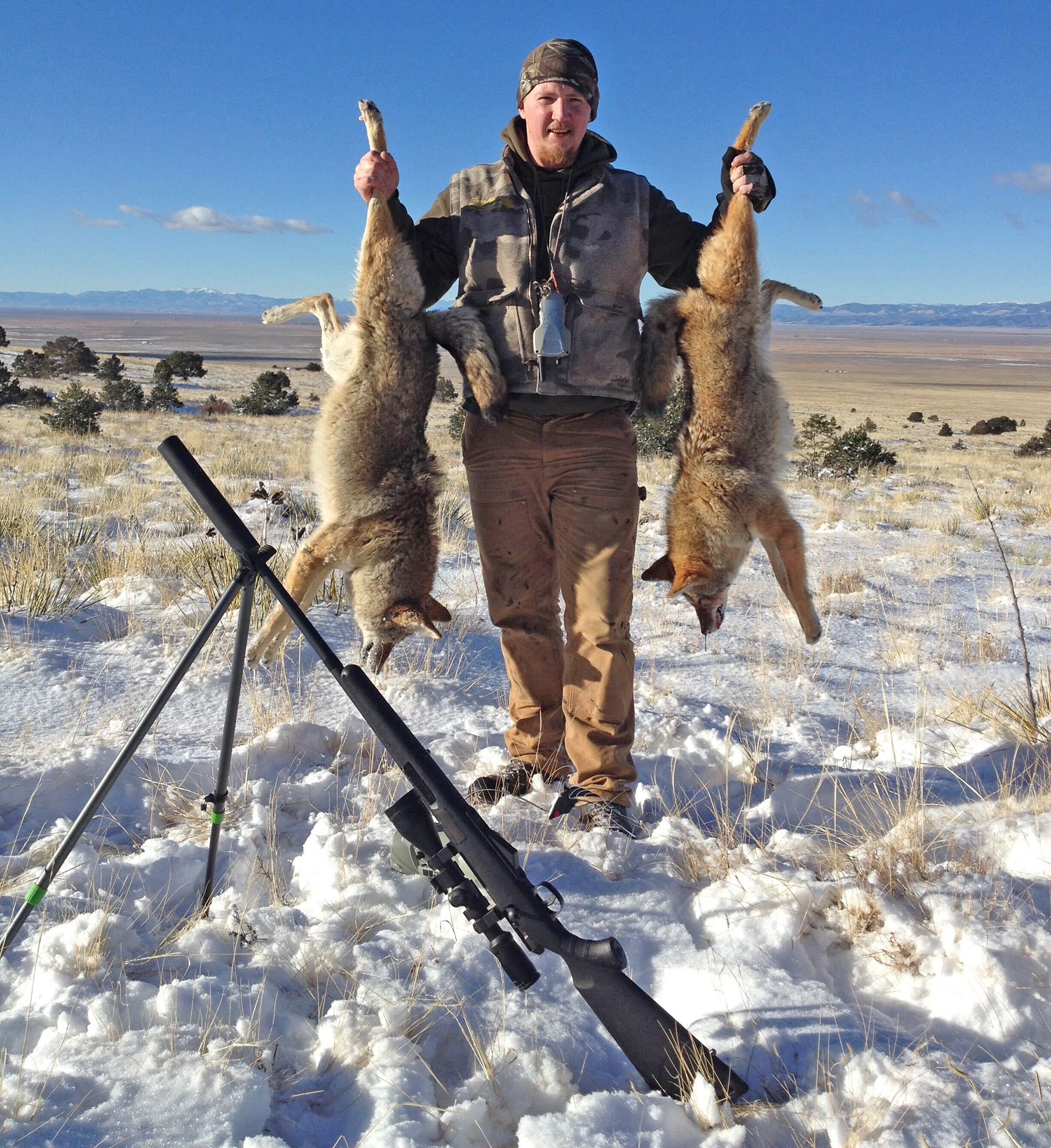
Final Thoughts
Coyote hunting is an important management tool in many areas, and it’s a tremendous amount of fun. Caliber and cartridge can contribute to your success, but if you’re just getting started in coyote hunting, use what you can get and don’t overthink it. You’ll likely find the challenge of learning to kill coyotes consistently more of a priority than fine-tuning your caliber and cartridge selection. Anything on this list is a good place to start, but as you develop your skills and style, you’ll be able to pick out exactly what works best for you.
